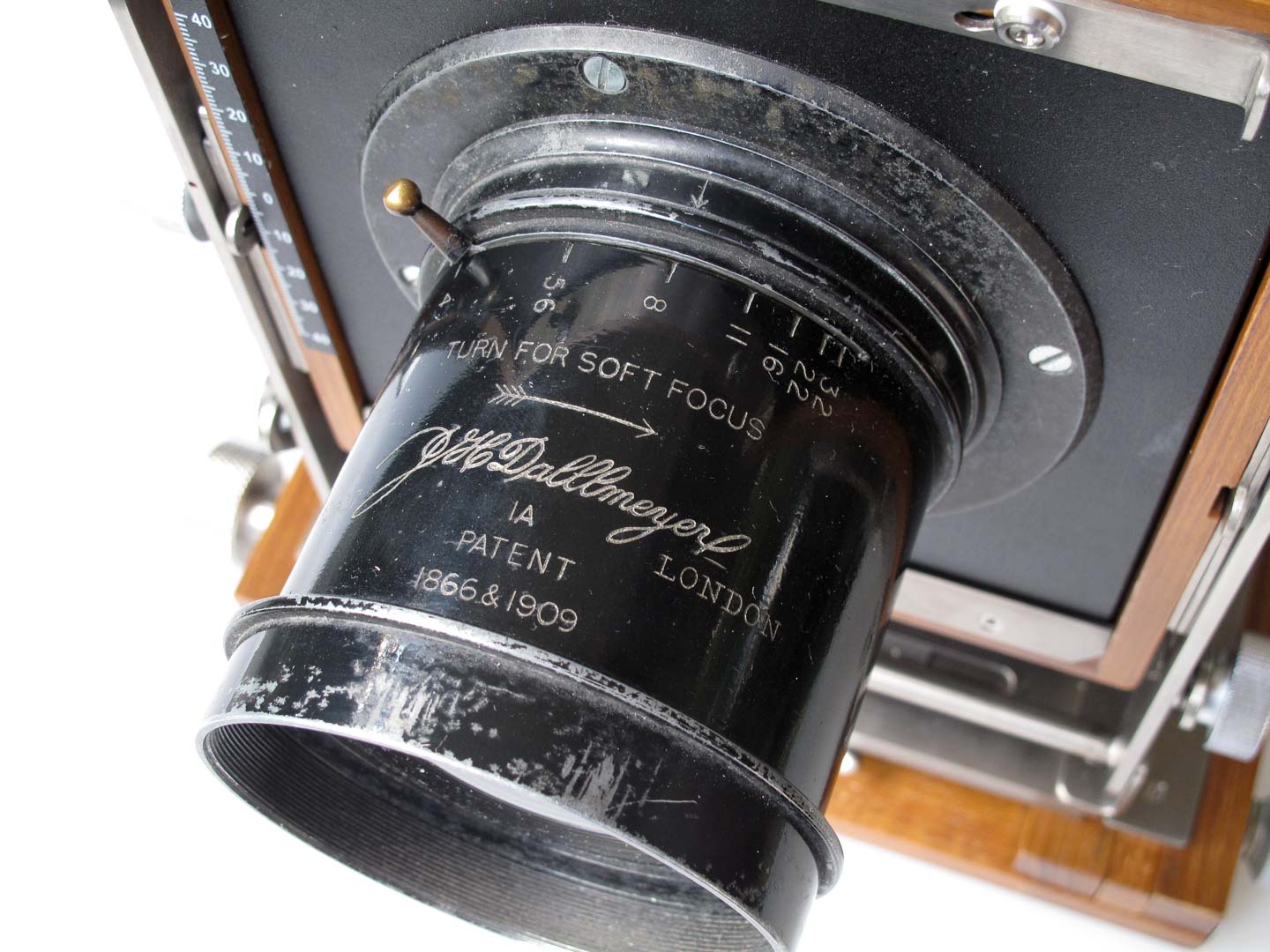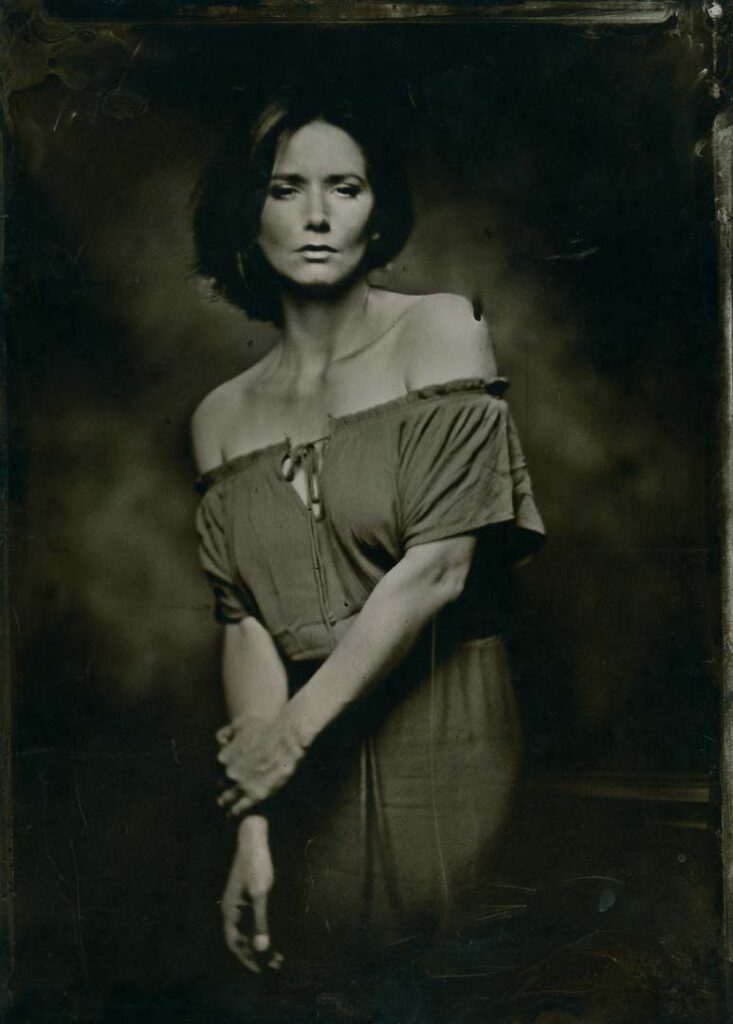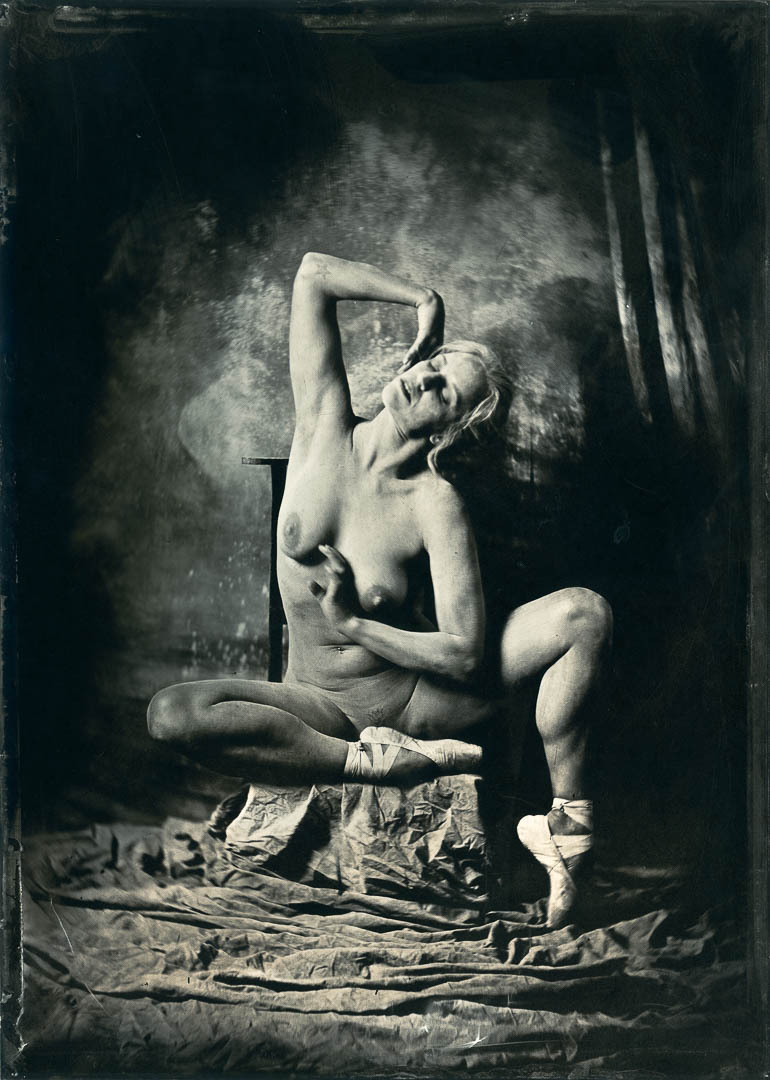This Dallmeyer 1A lens from around 1920 does not give the impression that you have to have it. Who wants such old photo accessories anyway? And since it is not made of brass, it is not even suitable for the display case.
I like something like that and that's why I bought it quite some time ago - not for the showcase, but to take photos with it.
Petzval lenses
Dallmeyer Lenses
Using Historical Lenses
None of these lenses have a built-in shutter, as is commonly found in newer large format lenses. The lenses must therefore be used with a separate shutter, which is located in front of or behind the lens. Few newer cameras offer this option, so using film at least at full aperture is difficult because of the fast shutter speeds.
The Dallmeyer 1A is just small enough for use with a Sinar behind-the-lens shutter Because the flange is relatively far forward on the lens, a plate with a 27 mm extension is required. I had such a plate made for me using 3D printing and used it for the picture taken at the cemetery with the Sinar 13×18. But before the next use, the plate broke without any external influence and the lens almost fell off. Since the lens is comparatively light due to the aluminum barrel, the risk of a plate breakage with heavy lenses is likely to be a lot higher. I can only strongly advise against using such plates for mounting high-quality lenses.
On the photo with the broken plate you can see that an adapter ring 77-82 is screwed into the lens at the front. The lens does not really have a thread, but the ring can still be screwed in. This ring is useful for a standard protective cover or for filter attachments, especially for strong gray filters when used outdoors with an open aperture.
However, because of the long exposure times, you can easily manage without a shutter for collodion wet plates. So I mounted the lens back on a flat Sinar plate and use a shutter like in the old days. For lack of a cylinder, I hold the focusing cloth in front of the lens until the exposure, then I count the seconds and cover it again.
Why and how I use this lens
One is inclined to believe that a lens that is a hundred years old does not provide good image quality. In fact, you can use it to take much sharper images than most people assume. Dallmeyer's lenses had an excellent reputation for good reason, and they still have it.
If you want sharp images, you can have it cheaper with a modern large format lens. However, the Dallmeyer patent lenses of series A and B have two special properties that modern large format lenses do not have.
On the one hand, they are faster than practically all modern large format lenses, so that a significantly smaller depth of field can be achieved. I therefore only use the lens with an open aperture.
On the other hand, these lenses are used for larger formats than specified. The Dallmeyer 1A is a 4×5 inch lens, but I practically always use it for 5x7 - almost twice as big. So it is kind of like using an APS-C lens for full frame. The Dallmeyer lens has few problems with this; it manifests itself in somewhat darker edge areas with a blur characteristic often referred to as swirly bokeh. The latter is less noticeable in the studio, however.
Virtually all of my 5×7 inch wet plates were shot with this lens. But I also use it for portraits and nudes on film. With one exception, I do not use a flash for this, but rather continuous light - either intense HMI light for wet plates, or pilot light for captures on film. All pictures are therefore taken with exposure times of around one to eight seconds. This is far from common today, but it is one of the reasons why these images have a different effect that also characterizes historical photographs. If you want to find out more about it, you are sure to read the Interview with Paolo Roversi. He is one of the most renowned fashion photographers and also photographed the Pirelli Calendar 2020. Even if he works digitally for it, you won't find a flash in his work.
Because of this reference to historical photography, my series of portraits and nudes on film is named "Century".
I now have other historical lenses for smaller and larger formats, but the principle behind the pictures is always the same.
The Dallmeyer 1A may not be a showcase, but it is one of my most important lenses. Others know that too, and such lenses are correspondingly rare. Above all, they are bought up by dealers in order to then drive up prices sharply. I just saw an offer for a brass version of the Dallmeyer 1A for which over € 2000 was being charged. The actual value is more like around € 800, for a Dallmeyer 3B around € 2000. That is a lot of money, but if I look at the current prices for modern lenses for digital cameras, then with a historical lens I not only get a rarity but also a lot more for the money in terms of photography.
The pictures on the right from the "Century” series were taken on film with the Dallmeyer 1A lens, those below are from my galleries with collodion wet plates, most of which were also made with this lens.



14. November 2025 Author d'Oréfice jp
Bonjour
google traduction est votre ami !!
j’ai abouti sur votre magnifique site en faisant des recherches sur l’objectif Dallmeyer……
il se trouve que je possède le même que vous mais je n’ai jamais réussi à regler le floux : que faut il “dévisser” ou visser?la partie avanr de l’objectif ? la partie arriere ? quel utilité de la petite fleche sur l’embase ? je n’arrive a devisser aucune partie..ou est ce le diaphragme qui regle le degré de floux ? la fleche semblerai indiquer le levier du diaphragme ?
Merci de me confirmer ce qu’il faut dévisser : WD40 est votre ami..
16. November 2025 Author ewald
Vielen Dank für den Kommentar, d’Orefice jp!
Das Dallmeyer 1A ist eines von drei Dallmeyer Objektiven die ich habe bzw. hatte. Dieses hatte ich mir (übrigens in Frankreich) für Wet Plates gekauft, die damals noch neu für mich waren. Dafür wollte ich wie du auch scharfe Bilder machen. Mein Objektiv hat aber genau das gleiche Problem wie deines: der Soft Fokus läßt sich nicht verstellen.
Mein Dallmeyer 3D war älter und aus Messing, es ist aber auch ein Objektiv aus der Petent Portrait Serie, wenn auch weniger lichtstark. Bei diesem Objektiv kann man die Hinterlinse auf eine von drei Soft Focus Markierungen etwas herausschrauben. Weil man dafür aber das Objektiv abnehmen muss, hat Dallmeyer das später wohl so geändert, dass man das auf der Vorderseite drehen kann – wenn es nicht klemmt wie meines auch 😉 Ich nehme an, dass das mit dem Aluminium zu tun hat.
Ich vermute, dass die Drehung den gesamten Tubus mit Ausnahme der Hinterlinse nach vorn schiebt, so dass sich auch dadurch der Abstand zwischen den beiden letzten Linsen vergrößert. Da das Objektiv einen durchgehenden Tubus hat, kann man den sicherlich nur am Flansch drehen. Ich hatte mir auch schon einmal überlegt ob ich es mit WD40 probieren soll, aber das Risiko Öl auf die Blende zu bekommen war mir zu hoch – auch wenn ich die noch nie gebraucht habe.
Auch wenn ich für Wet Plates keinen Soft Fokus einsetze und andere es oft gar nicht mögen, finde ich das durchaus für Fotografien auf Film interessant. Ich habe Objektive mit Siebblenden (darunter auch ein Imagon), die ich auch öfter einsetze. Ich kann aber damit leben, dass es mit dem 1A nicht geht – und du hoffentlich auch.
Ich spreche wenig Französisch, aber nicht gut. Deshalb versuche ich es mit DeepL, das sehr gut Übersetzungen macht:
—
Je parle un peu français, mais pas très bien. C’est pourquoi j’essaie DeepL, qui fait de très bonnes traductions :
Merci beaucoup pour ton commentaire, d’Orefice jp !
Le Dallmeyer 1A est l’un des trois objectifs Dallmeyer que je possède ou que j’ai possédé. Je l’avais acheté (en France, d’ailleurs) pour les Wet Plates, qui étaient encore nouvelles pour moi à l’époque. Comme toi, je voulais prendre des photos nettes. Mais mon objectif a exactement le même problème que le tien : le flou artistique ne peut pas être réglé.
Mon Dallmeyer 3D était plus ancien et en laiton, mais c’est aussi un objectif de la série Petent Portrait, bien que moins lumineux. Avec cet objectif, on peut dévisser légèrement la lentille arrière sur l’un des trois repères de mise au point douce. Mais comme il faut pour cela retirer l’objectif, Dallmeyer a probablement modifié cela par la suite afin de pouvoir le tourner à l’avant, quand il ne se bloque pas comme le mien 😉 Je suppose que cela a un rapport avec l’aluminium.
Je suppose que la rotation fait avancer l’ensemble du tube, à l’exception de la lentille arrière, ce qui augmente également la distance entre les deux dernières lentilles. Comme l’objectif a un tube continu, on ne peut certainement le tourner qu’au niveau de la bride. J’avais déjà envisagé d’essayer avec du WD40, mais le risque de mettre de l’huile sur le diaphragme était trop élevé à mon goût, même si je ne m’en suis jamais servi.
Même si je n’utilise pas de flou artistique pour les Wet Plates et que d’autres ne l’apprécient souvent pas, je trouve cela tout à fait intéressant pour les photographies sur pellicule. J’ai des objectifs avec des diaphragmes à tamis (dont un Imagon) que j’utilise souvent. Mais je peux m’accommoder du fait que cela ne fonctionne pas avec le 1A, et j’espère que toi aussi.
Ewald
1. November 2021 Author STADELMANN ADRIAN
Sehr beeindruckende Bilder. Ich würde es nun doch als Kunst betiteln, auch wenn das Handwerk, oder genau weil das Handwerkliche können ausschlaggebend ist. Gratulation zu diesen Werken!
Freundliche Grüsse aus der nahen Schweiz, Adrian
4. November 2021 Author ewald
Vielen Dank für diese Einschätzung, Adrian!
Ich habe mich nie als Künstler gesehen. Bei aller Begeisterung für das Handwerkliche freut es mich aber, dass man mehr als Handwerk in meiner Arbeit sehen kann.
Viele Grüße in die Schweiz, Ewald